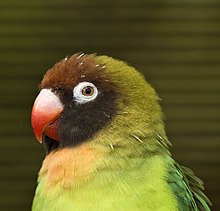William Lutley Sclater
William Lutley Sclater (born September 23, 1863 in Kensington , † July 7, 1944 in London ) was a British ornithologist and zoologist . He was the son of zoologist Philip Lutley Sclater and Jane Anne Eliza (1835-1025), daughter of Sir David Hunter-Blair. Sclater worked, among other things, as deputy director of the Indian Museum in Calcutta , as director of the South African Museum in Cape Town and the Colorado Museum in Colorado as well as at the Natural History Museum in London.
Professional background
In 1885 Sclater received a Master of Arts degree in Natural Sciences from Keble College , Oxford . A year later, in 1886, he gave his first lectures in zoology at University College in London and took part in expeditions to British Guiana . In 1887 he lectured in the same subject at the University of Cambridge .
From 1887 he was deputy director of the Indian Museum in Calcutta until he was appointed deputy director at Eton College in 1891 . In the same year his publication Catalog Of Mammalia In The Indian Museum, Calcutta, Part 2: Rodentis, Ungulata, Probosoides, Hyrscoidea, Carnivors, Cetaces, Sirenia, Marsupialis, Monotremata ( Directory of Mammals in the Indian Museum Calcutta, Part 2: Rodents , Ungulates , proboscis , hyrax , carnivores , whales , manatees , marsupials , monotremes ). He left Eton College in 1895 to become director of the South African Museum in 1896. He led the museum until 1906. During this time, appeared in 1898's list of the reptiles and batrachians of South Africa ( List of reptiles and amphibians of South Africa ), in 1899 he published together with his father Philip Sclater The geography of mammals ( Geography of mammals ) . Six years later, in 1905, there followed Notes on some recently rediscovered inscribed sones bearing on the history of the Cape Colony ( e.g. notes on recently rediscovered items with relevance to the history of the Cape Colony ).
In 1906 he moved from the South African Museum to the Colorado College Museum, where Sclater also held the post of director. In the same year he discovered the soot-head parrot , which he named Agapornis nigrigenis . In 1909 he gave up his position as director and moved to the Natural History Museum as a simple employee , where he worked until his death in 1944.
In 1912 he published the book A History of the Birds of Colorado ( A History of the Birds of Colorado out). Between 1913 and 1930 Sclater repeatedly published articles in the International Journal of Avian Science (IBIS) . In addition, he published other publications, such as 1918 A list of birds of the Anglo-Egyptian Sudan: Based on the collections of AL Butler, A. Chapman and H. Lynes and Cuthbert Christy ( List of birds in Anglo-Egyptian Sudan : based on on the collections of Arthur Lennox Butler (1873–1939), Abel Chapman (1851–1929), Hubert Lynes (1874–1942) and Cuthbert Christy (1863–1932) ), 1924 Systema avium aethiopicarum: A systematic list of the birds of the Ethiopian region ( Systema avium ethiopicarum: A systematic list of birds of the Ethiopian region ) and 1927 list of abbreviations with titles of periodicals Containing papers dealing with matters of zoological importance (such as list of abbreviations of titles of periodicals , the writings with matters of zoological importance included ). Between 1921 and 1938 he also wrote numerous entries in the Zoological Record , the core database for zoological purposes.
Sclater and his wife Charlotte traveled across the world between 1919 and 1920.
From 1928 to 1933 he was President of the British Ornithologists' Union , which publishes journals such as IBIS. In 1932, his publication Taxonomic and field notes on some birds of north-eastern Tanganyika Territory appeared ( taxonomy and notes on some birds of the area in northeast Tanganyika ). From 1931 to 1943 he was administrator of the Royal Geographical Society .
Sclater died in London in 1944 during World War II as a result of an injury sustained by German V1 bombs.
Private life
William Lutley Sclater's father, Philip Lutley Sclater , was also a zoologist. He got his first name William Lutley Sclater from his paternal grandfather, who was called William Lutley Sclater.
During his time in Eton (1891-1895) he met his future wife Charlotte Mellen Stephenson, whom he married in 1896. She died in 1942 of injuries sustained during the bombing of London .
Fonts (selection)
- with Philip Lutley Sclater : The geography of mammals. Kegan Paul, Trench, Trübner, London 1899. ( Digitized ; reprint: Arno Press, New York 1978, ISBN 0-405-10647-5 ).
- Catalog Of Mammalia In The Indian Museum, Calcutta. Part 2: Rodentis, Ungulata, Probosoides, Hyrscoidea, Carnivors, Cetaces, Sirenia, Marsupialis, Monotremata (1891). ( Digitized version ).
literature
- George R. Clerk and DAB, Obituary: William Lutley Sclater. In: The Geographical Journal. Vol. 104, no. 1/2, Jul. – Aug., 1944, pp. 68 f.
- Claude Henry Baxter Grant: William Lutley Sclater . In: The Ibis . tape 87 , no. 1 , 1945, p. 115–121 (Plate 1) ( online [accessed December 11, 2015]).
Individual evidence
- ↑ Draft chronological biography (English)
- ↑ a b W. L. Sclater at the South African Museum ( Memento from April 25, 2008 in the Internet Archive )
Web links
- ^ Family Group Descendant Tree
- ^ Homepage of the Indian Museum Kolkata ( Memento from February 8, 2006 in the Internet Archive )
- ↑ Colorado Museum ( Memento from June 26, 2008 in the Internet Archive )
| personal data | |
|---|---|
| SURNAME | Sclater, William Lutley |
| ALTERNATIVE NAMES | Sclater, William L. |
| BRIEF DESCRIPTION | British zoologist and ornithologist |
| DATE OF BIRTH | September 23, 1863 |
| PLACE OF BIRTH | Kensington (London) |
| DATE OF DEATH | July 7, 1944 |
| Place of death | London |

